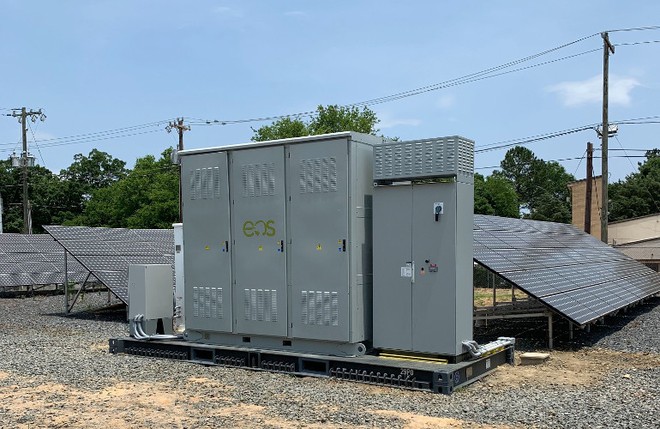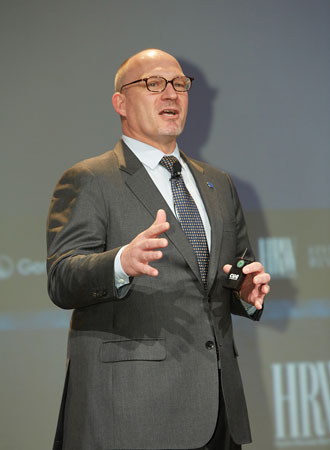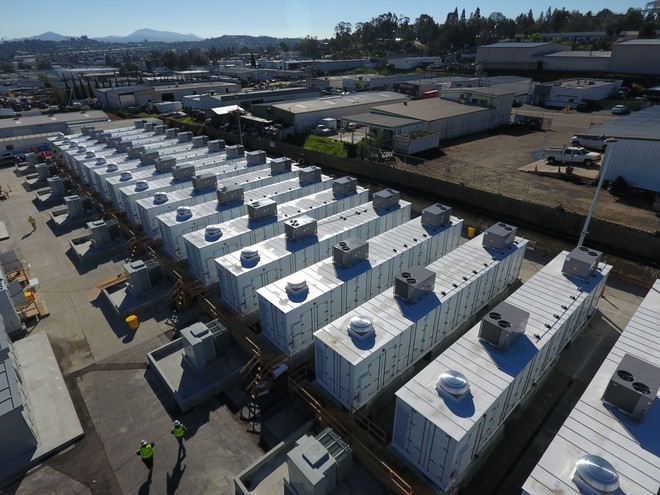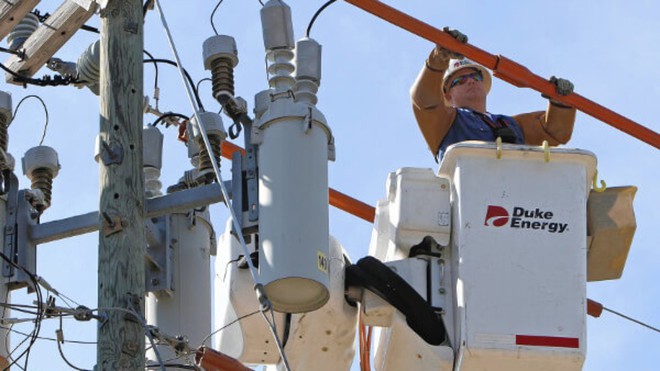The quest to replace Li-ion batteries has a brilliant representative: the Eos Zinc Battery.
Eos Energy Storage Company has spent 12 years researching to find that network storage technology can directly compete with lithium-ion batteries. The countless startups that nurtured this dream had long been shattered, but Eos still exists today. Even, Eos Energy Storage plans to issue shares for the first time, via a merger with a shell company.
B. Riley Principal Merger Corp. II, a company incorporated for acquisition (SPAC), will merge with Eos in the fourth quarter of this year, and Eos will be officially listed on the New York Stock Exchange. A merger with a SPAC will quickly give Eos a foothold in the market without the cumbersome procedures of a traditional IPO.
“This is the company that B. Riley has been eyeing for a few years now,” Dan Shribman, CEO of BPRM II said in June, when they announced their intention to merge. “We have reason to believe that Eos has great potential, generating significant returns for shareholders.”
Greenhouse gas startup Nikola Motor issued shares in a SPAC merger in June, although it did not sell any products, but its market capitalization reached $ 20 billion, more than Ford. former. Eos and B. Riley want to raise approximately $ 225 million in capital to support their battery production line.
But be clear: the automotive market and the energy market are very different, and the direction of Eos is particularly difficult. They seek to confront Li-ion batteries, a key technology in the industry which has had large-scale production lines which have been stable for many years; Eos wants to enter the energy storage industry, especially as the world has more and more new solutions for clean energy production.
Eos once intended to reverse the market with cheap electricity storage: in 2017, they announced their storage model for just around $ 95 / kilowatt hour. Since then Eos has changed heads – a former general manager of General Electric, and then they also have several kilowatt-scale pilot projects and an energy storage facility in the city. Pittsburgh, Pennsylvania, United States.
The energy storage market is growing, and tech companies are investing billions of dollars in capital in projects exploring new ways to store energy. In this race, famous new names get big business.
Large energy storage companies, such as Highview Power and Hydrostor, are investing their money in building megawatt experimental plants and are growing steadily. Eos is again focusing on building small factories, with a total capacity of just over 1 megawatt.
According to Joe Mastrangelo, CEO of Eos, after 12 years of development and investment of 160 million USD, Eos needs to change direction of investment. They no longer need to prove their energy or the reliability of the technology, they need to step up the development of industrial batteries, and to do this Eos needs more flexible financing.
“We look at the business and we ask ourselves, ‘What is the fastest and most economical way to increase the size of the business, the production line and the approach to the market? “And then the answer is here.” Mastrangelo explains his decision to issue shares. “This will allow us to financially pursue larger projects.”
Now, Eos must convince investors that its intellectual property, production lines, pilot projects and new business model are worth $ 290 million.
Exotic battery technology with incredible claims
At this point, the decision to invest in battery development is a wise one, but Eos’ approach is a bit risky.
The electric vehicle and electronics industries use Li-ion batteries, and the cost of batteries is falling. But lithium-ion energy storage technology is still too expensive to be used to store electrical waste from the national grid; They can catch fire or even explode in the event of a problem.
Eos wants to offer another solution.
For 12 years, they have been trying to develop a “hybrid zinc cathode” device. Within each energy cell is a carbon bonded cathode, with a ceramic coated and galvanized titanium collector, the entire structure contained in an electrolyte solution. It is a stationary system, as opposed to conventional batteries, with constantly moving currents.
Unlike li-ion batteries, these batteries do not require HVAC (heating, ventilation, air conditioning) to operate at safe temperatures. There are a few other startups using zinc to make batteries because of its low cost, including ViZn Energy, Fluidic, or e-Zinc. But no one was working on the development of hybrid zinc cathodes, and Eos had to convince customers that its technology was unique.
The hosting system is Aurora d’Eos.
Over the years, the company constantly affirms the uniqueness as well as the extremely low cost of its products. In 2017, Michael Oster – CEO of Eos and Philippe Bouchard – VP of Business Development of Eos told reporters that they were selling electricity storage services for just $ 160 / kilowatt hour. It is priced much cheaper than li-ion battery technology at the time. However, Eos talks about direct current (most power systems use alternating current), they do not include the cost of transferring current as well as the cost of installing the system.
A few months later, Eos continued to make even bolder statements. They issue press releases, promote the electric storage system for as little as $ 95 per kilowatt hour; The bargain price is only for people who wait 5 years to use their services by 2022. In 2019, when Greentech Media looked at Eos’ internal document, they saw that the cost of the DC system was $ 222. . per kilowatt hour, more than the price they were offering in 2017. Oster and Bouchard are now out of the business.
In an interview in 2017, Eos’ board said that by the summer of that year, they would launch their first megawatt system, funded and developed by a third party. Although the project is not yet complete, Eos has also signed a 10 megawatt / 40 megawatt hour battery contract with another company, but CEO Mastrangelo has now confirmed that Eos is not involved in the project. again.
Instead, they signed a contract with Greek oil company Motor Oil to supply 1 megawatt / 4 megawatt-hour batteries to a refinery in Athens; Motor Oil attaches great importance to the safety and low explosion potential of the batteries supplied by Eos. CEO Mastrangelo said if all goes well, this will be their opportunity to enter the industry, namely the oil and gas industry.
Replace the pilot, plus the old ’empty’ promises
Mastrangelo became CEO in 2019, after a year as an advisor to the board. Most of Eos’ current executives are “from” General Electric, experienced in renewables and smart grids.
Since the transfusion of the board, Eos no longer issues press releases with cheeky product price claims, instead focusing on actual products and advancements in capabilities. manufacturing. Today, Eos says it is already able to produce a device that contains 75 megawatt hours of electricity per year, and is expected to increase that to 500 megawatt hours per year over the next 12 months.
It’s hard to believe Eos has never run out of cash, which has beaten so many other energy storage startups. “This business has survived times when many other places cannot, and now is the time to grow, and then we will evolve to help the energy industry have safe and inexpensive storage systems. and can be easily extended, ”says Mastrangelo.
How will Eos handle the Li-ion battery?
During the period from the inception of Eos to the issuance of shares, the cost of Li-ion batteries continued to decline. Recently, Mastrangelo only said that Eos batteries are “very competitive” in price with Li-ion batteries, but no longer claim to be several times cheaper.
Eos also doesn’t focus on long-term energy storage, where Li-ion batteries are still weak due to the inability to scale efficiently. Eos only so that the system discharges electricity in about 4 hours, but the “strong” of the li-ion battery. However, the Eos is able to discharge electricity continuously for 10 hours without significantly affecting battery life.
This allows Eos to compete with Li-ion batteries in areas such as explosion, recyclability, and rate of degradation.
Eos says their system is filled with a hydrophilic electrolyte, so it can’t catch fire. This is what sets them apart from Li-ion batteries, which are very flammable.
But the unanswered question is: how do consumers think? The scandalous cases of battery explosion have never made customers falter with the use of Li-ion batteries, companies still buy Li-ion batteries, but companies still invest billions in technology. This weak. But from Eos’ point of view, customers are only “satisfied” with the li-ion battery because of the way of thinking, as long as the li-ion battery is economically efficient, and it doesn’t. there is no alternative technology. whichever is best.
Eos believes that as more companies know and trust their products, the Li-ion battery will face a formidable rival.
The first critical customer: Duke Energy
Last year, Duke Energy installed a 30 kilowatt / 120 kilowatt-hour system from Eos, to take a step-by-step project to explore high-potential grid technology. Eos technology is just one of many tools to support grid technology, and according to Tom Fenimore, a new technology expert at Duke Energy, the Eos battery has yet to replace the Li-battery. ion.
However, the Eos battery can still compete with the li-ion battery at an initial cost, because it has certain advantages in operation and maintenance, for example, the Eos zinc battery does not need. air conditioning or explosion-proof system.
“The Eos battery suitable for daily charging and discharging can enjoy 100% discharge capacity,” said expert Fenimore. However, Fenimore again noticed the weakness of zinc batteries, which consisted of running the daily charge-discharge cycle to minimize losses that occurred during the day if the battery was not in use.
Duke Energy will consider installing additional Eos energy storage systems once the battery company releases a new generation of products. This is what an emerging brand wants to hear from users, as well as the message they want to send to other potential customers.
Next step for Eos: we must win the hearts of its shareholders, then develop the strategy to face the li-ion battery.
Greentech Media








